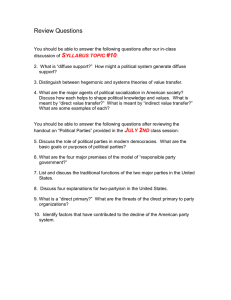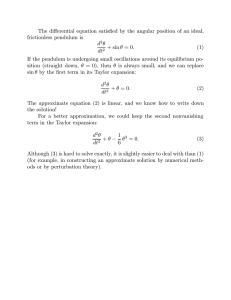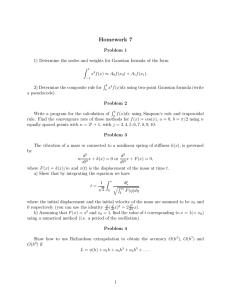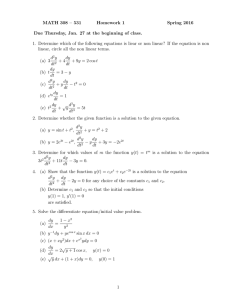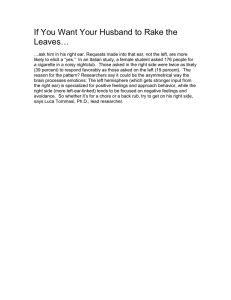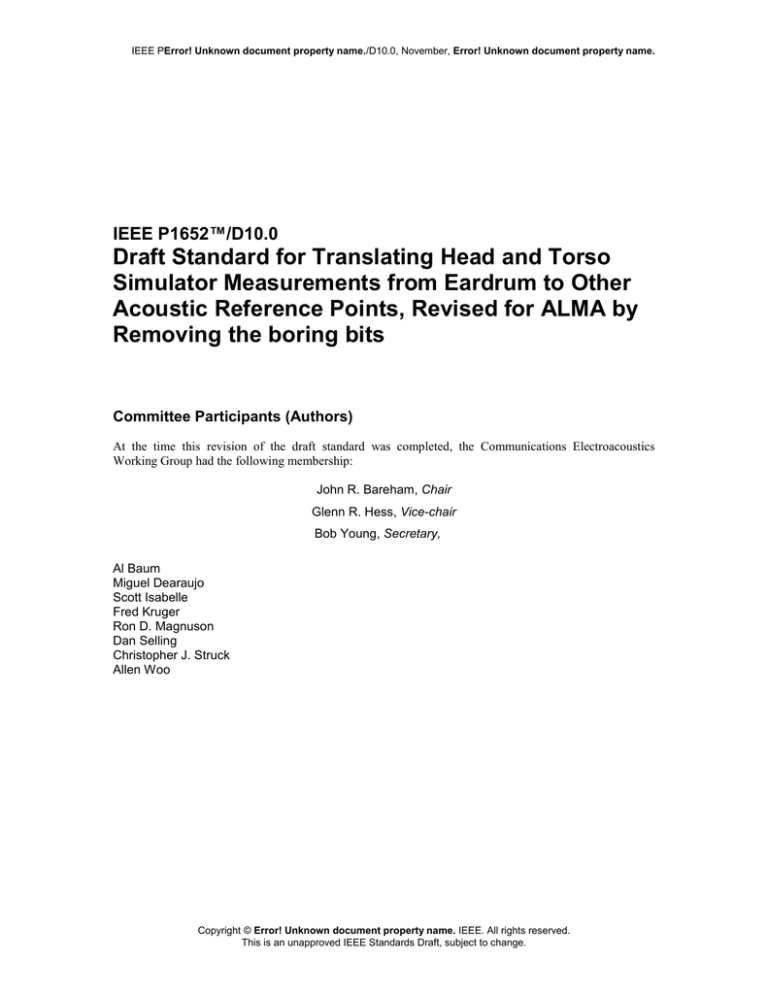
IEEE PError! Unknown document property name./D10.0, November, Error! Unknown document property name.
IEEE P1652™/D10.0
Draft Standard for Translating Head and Torso
Simulator Measurements from Eardrum to Other
Acoustic Reference Points, Revised for ALMA by
Removing the boring bits
Committee Participants (Authors)
At the time this revision of the draft standard was completed, the Communications Electroacoustics
Working Group had the following membership:
John R. Bareham, Chair
Glenn R. Hess, Vice-chair
Bob Young, Secretary,
Al Baum
Miguel Dearaujo
Scott Isabelle
Fred Kruger
Ron D. Magnuson
Dan Selling
Christopher J. Struck
Allen Woo
Copyright © Error! Unknown document property name. IEEE. All rights reserved.
This is an unapproved IEEE Standards Draft, subject to change.
Sponsor
Standards Development Board of the IEEE Communications Society
Copyright © 2015 by the Institute of Electrical and Electronics Engineers, Inc.
Three Park Avenue
New York, New York 10016-5997, USA
All rights reserved.
Foreword: According to IEEE rules, we are allowed to share the contents of this draft standard for the
purposes of receiving comments. Once the standard has been balloted and approved, hopefully early next
year, the contents belong to IEEE.
Abstract: This presentation will be useful for ALMA members who are not familiar with headphone
measurements on HATS and would like to know just why headphone frequency measurements, when done
properly, look far from “flat”. This presentation provides the data, techniques, and rationale for translating
Head and Torso Simulator measurements from the eardrum to other acoustic reference points, such as the
free field and the diffuse field. It applies primarily to measurements of devices that contact the ear, such as
headsets and mobile and telephone handsets. It can also be used for devices that do not contact the ear, such
as speakerphones and wearable devices. It is applicable to communication and multimedia audio devices
over the full band frequency range of 20 to 20 kHz.
Overview
Scope
This standard provides the data, techniques, and rationale for translating Head and Torso Simulator
measurements from the eardrum to other acoustic reference points, such as the free field and the diffuse
field. It applies primarily to measurements of devices that contact the ear, such as headphones, headsets and
handsets. It can also be used for devices that do not contact the ear, such as speakerphones and wearable
devices. It is applicable to communication and multimedia audio devices over the frequency range of 20 to
20 kHz.
Purpose
Common acoustic reference points are needed for comparing electroacoustic performance of handsets,
headphones, headsets, speakerphones and other kinds of communication devices. It is also needed for
comparing communication devices with other devices such as loudspeakers, multimedia terminals and
consumer audio equipment. The free field and diffuse field are appropriate reference points because the
results relate closely to what we hear. For measurements on communication devices, the free field or
diffuse field are more widely applicable reference points than the legacy ERP (ear reference point).
Normative references
The following referenced documents are indispensable for the application of this document. For dated
references, only the edition cited applies. For undated references, the latest edition of the referenced
document (including any amendments or corrigenda) applies.
ITU-T Recommendation P.57, Artificial Ears
ITU-T Recommendation P.58, Head and Torso Simulator for Telephonometry
1. Definitions
For the purposes of this draft standard, the following terms and definitions apply. The Authoritative
Dictionary of IEEE Standards, Seventh Edition, should be referenced for terms not defined in this clause.
diffuse field. Sound field in which the time average of the mean-square sound pressure is the same
everywhere and the flow of acoustic energy in all directions is equally probable.
ear-drum reference point (DRP). A point located at the end of the ear canal, corresponding to the eardrum position. Also known as the drum reference point.
ear reference point (ERP). A virtual point for acoustic and geometric reference located outside the
entrance to the ear canal. The exact location is specified for each type of ear simulator.
free field. (simple definition) Sound field free of reflections.
free field. (complete definition) Sound field in a homogenous, isotropic medium free from boundaries. In
practice, the effects of boundaries on a free field are negligible over the region of interest.
frequency response. Electrical, acoustic, or electroacoustic sensitivity (output/input), or gain, as a function
of frequency.
head and torso simulator (HATS) for telephonometry. A manikin incorporating a mouth simulator and
ear simulator(s), extending downward from the top of the head to the waist, designed to simulate the sound
pick-up characteristics and acoustic diffraction produced by a median human adult and to reproduce the
acoustic field generated by the human mouth. See ITU-T Recommendation P.58.
orthotelephonic. A talker and a listener communicating by speech, face to face, one meter apart, in a quiet,
approximately anechoic environment.
receiver. An electroacoustic transducer that converts an electrical signal to sound and delivers it directly to
the ear, sealed or unsealed.
speaker (also loudspeaker). An electroacoustic transducer that converts an electrical signal to sound and
delivers it to the ear from a distance of several centimeters or greater.
spectrum. A distribution of amplitude (or phase, or some other quantity) as a function of frequency. It is
often expressed in bands. Bands may be of constant percentage width, such as 1/3rd or 1/12th octave bands
(~23 % and ~6 % of the center frequency, respectively). Bands may also be of fixed width, regardless of
center frequency (e.g. 50 Hz). Instead of bands, a spectrum may also be expressed as spectrum density,
which is equivalent to 1 Hz bands.
2. The listening experience
The fundamental goal of ear related measurements is to correlate to the listener’s subjective experience. In
order to do that, a head and torso simulator (HATS) is used to simulate the physical part of the listener
experience up to the eardrum. A HATS has an ear simulator that picks up sound at the drum reference point
(DRP). Translations that convert from DRP to a listener reference point (LRP) more completely represent
the user’s listening experience. Free field (FF), diffuse field (DF), and in limited cases ear reference point
(ERP), are typical LRPs.
3. Free Field (FF)
3.1 Origin of the HATS free field translation
Loudspeakers deliver sound to the listener without contacting the listener’s head.
Figure 1
— Loudspeaker and listener in free field
In general, loudspeaker-based audio systems that are considered to be high fidelity will exhibit a relatively
flat frequency response in the free field, typically measured in an anechoic chamber. Thus a “flat”
frequency response is considered to be one major indicator of high-quality sound reproduction. (Figure 2
and Figure 3)
Figure 2
— Loudspeaker and microphone in anechoic chamber (free field)
Figure 3
— Equalized (flat) loudspeaker spectrum at 90dBSPL measured in free field with a
microphone
Figure 4
— Loudspeaker and HATS in anechoic chamber (free field)
Figure 5
— Equalized loudspeaker spectrum measured in free field with HATS eardrum (DRP)
A loudspeaker equalized to flat frequency response, measured at the ear drum reference point (DRP) of
HATS is shown in Figures 4 and 5. The response includes the effect of body, head, and especially the pinna
and ear canal.
Figure 6
— HATS free field translation (FF 0_0 to DRP)
3.2 The free field listening experience and the HATS free field translation
Most people prefer to have face-to-face conversations in a free field, or in an environment with few
reflections and minimal reverberation, where the direct path is the strongest component. Under these
conditions intelligibility is good and listening effort is low.
Communication devices are intended to approximate the acoustical experience of a face-to-face
conversation in a free field. The face-to-face conversation is therefore fundamental in evaluating such
devices. Even when the device is placed on the ear and partly or completely covers it, the acoustical
performance should nonetheless be evaluated using the face-to-face reference. This face-to-face
conversation is sometimes called the orthotelephonic reference.
Figure 7
Figure 8
— Face-to-face conversation in free field
— Talker and microphone in free field
Figure 9
— Example of talker spectrum at 64dBSPL measured in free field with microphone
Figure 10
— Talker and HATS in free field
Figure 11
— Talker spectrum at 64dBSPL measured with HATS at eardrum (DRP) in free field
Figure 12
— Translating talker spectrum from HATS DRP to free field
Figure 13
— Talker spectrum at 64dBSPL translated to free field
3.3 Applying the free field translation curve and tabulated data
For most communication devices, the reference is a face-to-face conversation at 1 meter distance, in an
environment with few reflections and little reverberation (see orthotelephonic definition). Measurements
should therefore be translated from the DRP to the free field. The correct free field translation is for an
incidence angle of 0 degrees azimuth and 0 degrees elevation (FF 0_0).
The FF 0_0 to DRP translation shall be subtracted from the data measured at the DRP in order to translate
to the FF. (Subtraction in dB is equivalent to division in linear units.) The effect is to remove a broad peak
of about 18 dB in the region of 3000 Hz.
Figure 14
— HATS Free field translation (FF 0_0 to DRP)
4. Diffuse Field (DF)
Most people prefer to listen to music in a relatively diffuse field, or in an environment with many
reflections and some reverberation.
Music listening devices are intended to approximate the acoustical experience of listening to music in a
diffuse field. Listening in a diffuse field is therefore fundamental in evaluating such devices. Even when
the device is placed on the ear and partly or completely covers it, the acoustical performance should
nonetheless be evaluated using the diffuse field reference.
4.1 The diffuse field listening experience and the HATS diffuse field translation
Diffuse field translation should be used for most entertainment and noise exposure applications.
Figure 15
— Music and listener in diffuse field
Figure 16
Figure 17
— Music and microphone in diffuse field
— Example music spectrum at 90dBSPL measured in diffuse field with microphone
Figure 18
Figure 19
— Music and HATS in diffuse field
— Music example of Fig.17, measured with HATS at eardrum (DRP) in diffuse field
Figure 20
Figure 21
— Translating music spectrum from HATS DRP to diffuse field
— The same music example as in Fig. 17, translated to diffuse field
4.2 Applying the diffuse field translation curve
The DF to DRP translation shall be subtracted from the data measured at the DRP in order to translate to
the DF. (Subtraction in dB is equivalent to division in linear units.) The effect is to remove a broad peak of
about 14 dB in the region of 3000 Hz.
Figure 22
— Diffuse field translation (DF to DRP)
5. (informative)
Bibliography
[B1] IEEE Standard 269, IEEE Standard Methods for Measuring Transmission Performance of Analog
and Digital Telephone Sets, Handsets and Headsets

